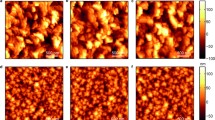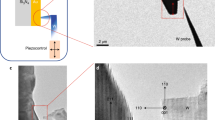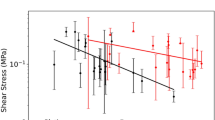Abstract
On the most fundamental level, nanoscale wear can be considered as a process of atom-by-atom removal during mechanical contact between surfaces. But at the same time, nanoscale wear processes are often accompanied by the formation of quasi-periodic surface structures, i.e., ripples, in a self-enhancing process driven by lateral force variations. Understanding and potentially controlling the complex mechanisms of ripple formation are interesting from a general tribological point of view, since our experiments bridge the gap between the early stages of atomic scale wear to the ensuing phenomena of abrasive wear on larger length scales. In this work, we have now analyzed this phenomenon by reciprocating single asperity scratching of an atomic force microscopy (AFM) tip across a flat surface of an ionic crystal under ultrahigh vacuum (UHV) conditions. In particular, the influence of dynamic scan parameters like sliding velocity \(v_{x}\) and the vertical adjustment velocity for topography changes \(v_{z}\) has been explored. Our experiments show that the sliding velocity \(v_{x}\) does not influence friction, wear, and the resulting surface structure, with the latter confirming numerical simulations for ripple formation. However, the vertical velocity \(v_{z}\) can be used as a direct control parameter for ripple formation, where low values of \(v_{z}\) seem to enhance the elastic instabilities that drive the surface patterning.
Graphical Abstract








Similar content being viewed by others
Data Availability
The data that support the findings of this manuscript are available from the corresponding author upon request.
References
Jost, H.P.: Tribology—origin and future. Wear 136(1), 1–17 (1990)
Archard, J.: Contact and rubbing of flat surfaces. J. Appl. Phys. 24(8), 981–988 (1953)
Zhao, K., Aghababaei, R.: Adhesive wear law at the single asperity level. J. Mech. Phys. Solids 143, 104069 (2020)
Gnecco, E.: Selected Topics in Contact Mechanics and Nanotribology, pp. 1161–1170. Springer, Cham (2020). https://doi.org/10.1007/978-3-030-46906-1_35
Gotsmann, B., Lantz, M.A.: Atomistic wear in a single asperity sliding contact. Phys. Rev. Lett. 101(12), 125501 (2008)
Bhaskaran, H., et al.: Ultralow nanoscale wear through atom-by-atom attrition in silicon-containing diamond-like carbon. Nat. Nanotechnol. 5(3), 181–185 (2010). https://doi.org/10.1038/nnano.2010.3
Wang, W., Dietzel, D., Schirmeisen, A.: Thermal activation of nanoscale wear. Phys. Rev. Lett. 126(19), 196101 (2021)
Wang, Y., et al.: Non-empirical law for nanoscale atom-by-atom wear. Adv. Sci. 8(2), 2002827 (2021)
Gnecco, E., Meyer, E.: Fundamentals of Friction and Wear on the Nanoscale. Springer, Cham (2015)
Tambe, N.S., Bhushan, B.: Friction model for the velocity dependence of nanoscale friction. Nanotechnology 16(10), 2309 (2005)
Carpick, R.W., Salmeron, M.: Scratching the surface: fundamental investigations of tribology with atomic force microscopy. Chem. Rev. 97(4), 1163–1194 (1997)
Gnecco, E., Bennewitz, R., Meyer, E.: Abrasive wear on the atomic scale. Phys. Rev. Lett. (2002). https://doi.org/10.1103/physrevlett.88.215501
Maw, W., Stevens, F., Langford, S., Dickinson, J.: Single asperity tribochemical wear of silicon nitride studied by atomic force microscopy. J. Appl. Phys. 92(9), 5103–5109 (2002)
Bennewitz, R., Dickinson, J.: Fundamental studies of nanometer-scale wear mechanisms. MRS Bull. 33(12), 1174–1180 (2008)
Jacobs, T.D.B., Carpick, R.W.: Nanoscale wear as a stress-assisted chemical reaction. Nat. Nanotechnol. 8(2), 108–112 (2013). https://doi.org/10.1038/nnano.2012.255
Filippov, A.E., Popov, V.L., Urbakh, M.: Mechanism of wear and ripple formation induced by the mechanical action of an atomic force microscope tip. Phys. Rev. Lett. (2011). https://doi.org/10.1103/physrevlett.106.025502
Sheehan, P.: The wear kinetics of NaCl under dry nitrogen and at low humidities. Chem. Phys. Lett. 410(1–3), 151–155 (2005). https://doi.org/10.1016/j.cplett.2005.05.060
Socoliuc, A., Gnecco, E., Bennewitz, R., Meyer, E.: Ripple formation induced in localized abrasion. Phys. Rev. B 68(11), 115416 (2003)
Leung, O.M., Goh, M.C.: Orientational ordering of polymers by atomic force microscope tip–surface interaction. Science 255(5040), 64–66 (1992)
Bolle, M., Lazare, S.: Large scale excimer laser production of submicron periodic structures on polymer surfaces. Appl. Surf. Sci. 69(1–4), 31–37 (1993)
Hiraoka, H., Sendova, M.: Laser-induced sub-half-micrometer periodic structure on polymer surfaces. Appl. Phys. Lett. 64(5), 563–565 (1994)
Moses, E., Kume, T., Hashimoto, T.: Shear microscopy of the “butterfly pattern’’ in polymer mixtures. Phys. Rev. Lett. 72(13), 2037 (1994)
Ko, H., Park, H., Jiang, J., Caron, A.: Nanoscopic wear behavior of face centered cubic metals. Acta Mater. 147, 203–212 (2018)
Rusponi, S., Boragno, C., Valbusa, U.: Ripple structure on Ag (110) surface induced by ion sputtering. Phys. Rev. Lett. 78(14), 2795 (1997)
Rusponi, S., Costantini, G., Boragno, C., Valbusa, U.: Ripple wave vector rotation in anisotropic crystal sputtering. Phys. Rev. Lett. 81(13), 2735 (1998)
Such, B., Krok, F., Szymonski, M.: AFM tip-induced ripple pattern on AIII-BV semiconductor surfaces. Appl. Surf. Sci. 254(17), 5431–5434 (2008)
Chey, S.J., Van Nostrand, J.E., Cahill, D.G.: Surface morphology of Ge (001) during etching by low-energy ions. Phys. Rev. B 52(23), 16696 (1995)
Borowiec, A., Haugen, H.: Subwavelength ripple formation on the surfaces of compound semiconductors irradiated with femtosecond laser pulses. Appl. Phys. Lett. 82(25), 4462–4464 (2003)
Teichert, C.: Self-organization of nanostructures in semiconductor heteroepitaxy. Phys. Rep. 365(5–6), 335–432 (2002)
Chan, W.L., Chason, E.: Sputter ripples and radiation-enhanced surface kinetics on Cu (001). Phys. Rev. B 72(16), 165418 (2005)
Krok, F., Saeed, S., Postawa, Z., Szymonski, M.: Ballistic versus electronic processes in ion-induced nanostructuring of ionic surfaces. Phys. Rev. B 79(23), 235432 (2009)
Huang, M., Zhao, F., Cheng, Y., Xu, N., Xu, Z.: Origin of laser-induced near-subwavelength ripples: interference between surface plasmons and incident laser. ACS Nano 3(12), 4062–4070 (2009)
Pan, Y., et al.: Threshold dependence of deep-and near-subwavelength ripples formation on natural MoS\(_{2}\) induced by femtosecond laser. Sci. Rep. 6, 19571 (2016)
Martínez, P.J., Gnecco, E., Mazo, J.J.: Numerical study of pattern formation in compliant surfaces scraped by a rigid tip. Phys. Rev. E 103(2), 022802 (2021)
Bilas, P., Romana, L., Kraus, B., Bercion, Y., Mansot, J.: Quantitative characterization of friction coefficient using lateral force microscope in the wearless regime. Rev. Sci. Instrum. 75(2), 415–421 (2004)
Schwarz, U., Köster, P., Wiesendanger, R.: Quantitative analysis of lateral force microscopy experiments. Rev. Sci. Instrum. 67(7), 2560–2567 (1996)
Gnecco, E., et al.: Surface rippling induced by periodic instabilities on a polymer surface. N. J. Phys. 17(3), 032001 (2015)
Bradley, R.M., Shipman, P.D.: Theory of the oscillatory instability of a rigid tip scraped over a polymer surface. Phys. Rev. E 106(5), 054803 (2022)
Mazo, J.J., Dietzel, D., Schirmeisen, A., Vilhena, J., Gnecco, E.: Time strengthening of crystal nanocontacts. Phys. Rev. Lett. 118(24), 246101 (2017)
Gnecco, E., Bennewitz, R., Gyalog, T., Meyer, E.: Friction experiments on the nanometre scale. J. Phys. Condens. Matter 13(31), R619 (2001)
Sang, Y., Dubé, M., Grant, M.: Thermal effects on atomic friction. Phys. Rev. Lett. 87(17), 174301 (2001)
Gnecco, E., Riedo, E., King, W.P., Marder, S.R., Szoszkiewicz, R.: Linear ripples and traveling circular ripples produced on polymers by thermal AFM probes. Phys. Rev. B 79(23), 235421 (2009)
Acknowledgements
WW acknowledges funding from the financial support by the NSFC (Grant Nos. 11890672, 12172309, 11602205), NSFSC (Grant No. 2022NSFSC1917), and the Analytical and Testing Center of Southwest Jiaotong University for the AFM measurements. DD and AS thank the German Research Foundation (Projects DI917/7-1, DI917/8-1, SCHI619/10-1) for providing the financial support.
Funding
This work is supported by the NSFC (Grant Nos. 11890672, 12172309, 11602205), NSFSC (Grant No. 2022NSFSC1917) and the German Research Foundation (Projects DI917/7-1, DI917/8-1, SCHI619/10-1).
Author information
Authors and Affiliations
Contributions
WW conducted the measurements. WW and DD wrote the main manuscript text and WW prepared figures. AS supervise the project. All authors reviewed the manuscript.
Corresponding authors
Ethics declarations
Conflict of interest
The authors have no relevant financial or non-financial interests to disclose.
Additional information
Publisher’s Note
Springer Nature remains neutral with regard to jurisdictional claims in published maps and institutional affiliations.
Appendices
Appendix
A: Vertical Velocity Calibration of the Piezo Scanner
In our AFM system (Omicron UHV VT-AFM), the normal force feedback is made available by the user-interface as a single integral-gain parameter whose magnitude can be changed between 0 and 100%, while no proportional gain is applied.
To quantify the vertical movement of the piezo scanner, we have started an AFM image without the tip being in contact with the sample. In addition, the usual signal of the photo-diode related to the bending of the cantilever was disconnected from the control unit and replaced by a sinusoidal input voltage (Fig. 8a). This configuration allows to monitor the vertical velocity of the piezo tube as a function of the feedback settings. Figure 8b, c then show the obtained piezo displacement as a function of time with feedback settings of 0.05% and 10% (please note that we have manually shifted the minima values of the piezo vertical displacement to 0).
As input, we have chosen relatively high voltages. In this case, the output voltage of the initial differential amplifier is mostly saturated throughout the oscillation cycle which results in a rectangular voltage input to the integrator. The integration of this input then leads to a linearly changing piezo displacement. From the slopes of the piezo displacement curves (red lines, Fig. 8a) we can determine the maximum velocity \(v_{z}\) for vertical piezo movement for a given feedback setting.
In our experiments, \(v_{z}\) has been found to scale linearly with the feedback setting values (Fig. 8d). Overall \(v_{z}\) thus appears to be a good parameter to characterize the feedback operation since the vertical velocity range with which the integral controller can modify the piezo position is limited by \(v_{z}\) and thus by the feedback value.
Typical input voltage curve and the vertical velocity of the piezo displacement at different feedback settings. a A typical sinusoidal input signal with an amplitude of 1 V and frequency of 20 Hz was used as the input of the photo-diode. In order to keep the output of photo-diode a constant, the piezo tube retracts and extends. Since a high input voltage was used, the initial differential-amplifier mostly saturates and b and c show the linearly varying piezo displacement curves as a function of time with the feedback settings of 0.05% and 10%, respectively. The vertical velocity of the piezo scanner \(v_{z}\) can be obtained by linear fits as illustrated by the red solid lines. d The value of \(v_{z}\) increases linearly with increasing feedback settings (Color figure online)
B: Typical Curves Recorded Both for the Trace and Retrace Scan
Figure 9a–d show the trace (blue solid lines) and retrace (red dash lines) results obtained at \(v_{z}\) = 51 nm/s while Fig. 9e–h show the similar results obtained at a larger \(v_{z} = 5096\) nm/s. For both values of \(v_{z}\) the data has been recorded after a prominent ripple structure had already been formed. The vertical black arrows clearly indicate correlations between lateral force, tip displacement (\(z_{{\text {tip}}}\)) and the differential of \(z_{{\text {tip}}}\) for the backwards scan. Similar to the trace analysis in Fig. 3, the tip tends to remain at a given position on the surface (or is at least slowed down considerably) while the lateral force is already building up. Only once a sufficient lateral force is reached, the tip slides up to the top of the mound. When the tip is on the way down the mound, lateral force decreases in the beginning and reaches its minimum directly after the mound, then lateral force starts to increase again.
Representative scan-lines with \(v_{z}=51\) nm/s (left panels) and \(v_{z}=5096\) nm/s (right panels) obtained after a prominent ripple structure had already been formed for a and e normal force, b and f lateral forces recorded during the trace (blue solid lines) and retrace scan (red dash lines). c and g z-Displacement of the AFM tip (\(z_{{\text {tip}}}\)) and d and h The calculated differential of \(z_{{\text {tip}}}\). In addition, the vertical black dash lines indicate the correlation between the different channels for the retrace scan (Color figure online)
C: Ripples on KBr and NaCl
As specified in the data sheets, the initial radius of our diamond tips is approximately 10 nm. When using another one of these tips and after scanning 0.5 h on NaCl (001) surface, the adhesion force increased from approximately 0.7 nN to 1.4 nN and we estimate that the stable tip radius is \(\sim\) 14 nm by considering the fact that the adhesion force scales linearly with the contact area. The observed periodicity of the ripples on KBr for this tip was found to be approximately 40 nm which is very close to the estimated tip diameter. In addition, we also did measurements on a NaCl surface and also for this material we found the periodicity of the ripples to be roughly 40 nm. This further corroborates concepts where the distance between ripples reflects the tip radius (see Fig. 10 for more details).
D: Phase Velocity
By following the maxima height of ripples in Fig. 2 over many scanning cycles, we can trace the position of individual ripples along the fast scan direction as a function of scan time as shown in Fig. 11. It appears evident that the ripples move from left to right during subsequent scans, and therefore, we can calculate their corresponding phase velocities by performing linear fits (solid black lines in Fig. 11). The estimated phase velocity is \(-0.11 \pm 0.03\) nm/s for \(v_{z}\) = 51 nm/s and is \(-0.20 \pm 0.10\) nm/s for \(v_{z}\) = 5096 nm/s. Please note the negative values indicate that the ripples move from right to left. Both values are four orders of magnitude lower than the scan velocity of \(v_{x} = 1250\) nm/s. In the previous work done by Gnecco et al. [42], a slow phase velocity which is two orders of magnitude lower than the scan velocity for circular ripples on the polymer surface was also observed. Although we do not have a good understanding at this point, we assume that the phase velocity may depend on the tip shape and substrate material.
Ripple position as a function of scan time. The data points were derived from Fig. 2 by tracing the maxima height of ripples
Rights and permissions
Springer Nature or its licensor (e.g. a society or other partner) holds exclusive rights to this article under a publishing agreement with the author(s) or other rightsholder(s); author self-archiving of the accepted manuscript version of this article is solely governed by the terms of such publishing agreement and applicable law.
About this article
Cite this article
Wang, W., Dietzel, D. & Schirmeisen, A. Control of Nanoscale Ripple Formation on Ionic Crystals by Atomic Force Microscopy. Tribol Lett 71, 28 (2023). https://doi.org/10.1007/s11249-023-01694-8
Received:
Accepted:
Published:
DOI: https://doi.org/10.1007/s11249-023-01694-8








